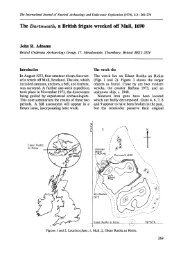port henderson : past & present - Royal Commission on the Ancient ...
port henderson : past & present - Royal Commission on the Ancient ...
port henderson : past & present - Royal Commission on the Ancient ...
You also want an ePaper? Increase the reach of your titles
YUMPU automatically turns print PDFs into web optimized ePapers that Google loves.
Port Henders<strong>on</strong> were built to c<strong>on</strong>form in some small way with this proposal and as already stated Port<br />
Henders<strong>on</strong> became a fishing village in 1815. Although <strong>the</strong>re was no real harbour, no school (except for<br />
<strong>the</strong> SSPCK <strong>on</strong>e, see p.40) or church, <strong>the</strong> <strong>on</strong>ly houses were situated <strong>on</strong> <strong>the</strong> shore with gardens to <strong>the</strong><br />
rear and <strong>the</strong> census of 1851 records that <strong>the</strong>re were 17 fishermen in <strong>the</strong> village. According to <strong>the</strong> early<br />
Estate Records (1830 - 40) <strong>the</strong> numbers of <strong>the</strong> tenants, about 22 names, matched <strong>the</strong> number <strong>on</strong> <strong>the</strong><br />
original sett of 1815 (see p.32) which would <strong>the</strong>n match <strong>the</strong> Estate’s numbering of <strong>the</strong> first crofts.<br />
Fishing for herring took place relatively close to <strong>the</strong> shore, about five to ten miles out and small<br />
line fishing, with a lighter weight line, was used although in <strong>the</strong> early 1880s Mr. Russell, <strong>the</strong> parish<br />
minister in 1836, stated that Gairloch herring was taken in nets. Because herring is an oily fish it has to<br />
be cured in barrels. In <strong>the</strong> 1880s many of <strong>the</strong> young men in <strong>the</strong> Gairloch area went to places like<br />
Peterhead, Fraserburgh and Wick for <strong>the</strong> summer herring fishing.<br />
Small boats could be beached at Port Henders<strong>on</strong> but larger boats moored at Badachro where<br />
<strong>the</strong>re was a landing stage.<br />
Cod fishing<br />
In <strong>the</strong> 19 th century up to <strong>the</strong> early years of <strong>the</strong> 20 th century cod was caught using <strong>the</strong> l<strong>on</strong>g-line which<br />
was a l<strong>on</strong>g fishing-line with thousands of hooks attached. However, <strong>the</strong>re was <strong>the</strong>n <strong>the</strong> initial expense<br />
of buying <strong>the</strong> bait (although local mussels were used, see p.18). Cod was prized for its white tasty<br />
flesh. It was easy to catch and preferred shallow waters where warm and cold currents merged. The<br />
seas<strong>on</strong> for cod was between February and April and near Port Henders<strong>on</strong>, <strong>on</strong> Eilean Horisdale and Dry<br />
Island and at <strong>the</strong> village of Badachro, <strong>the</strong>re were fish-curing stati<strong>on</strong>s. (The specificati<strong>on</strong>s for <strong>the</strong><br />
building of <strong>the</strong> pier and curing house at Badachro were set out in a paper dated August 14 th 1849 in <strong>the</strong><br />
presence of John Mackenzie, for <strong>the</strong> Gairloch Estate, and witnessed by Thomas Anders<strong>on</strong>. The<br />
c<strong>on</strong>tractors were William Henders<strong>on</strong> and S<strong>on</strong>. It is interesting to note <strong>the</strong>se names. Could <strong>the</strong> fishing<br />
village name of Port Henders<strong>on</strong> have been derived from <strong>the</strong>se c<strong>on</strong>tractors? Were <strong>the</strong>y working in <strong>the</strong><br />
area earlier?) In 1826 a James Henders<strong>on</strong> of Clyth, a fish curer <strong>on</strong> <strong>the</strong> east coast, went to Ullapool. It<br />
was his plan to establish stores at different stati<strong>on</strong>s around <strong>the</strong> coast for <strong>the</strong> recepti<strong>on</strong> of salt and casks<br />
which would enable <strong>the</strong> fishermen to deposit <strong>the</strong> fish <strong>the</strong>y had caught without any loss of time. Was<br />
this <strong>the</strong> same Henders<strong>on</strong>? The fish (and herring included) would be salted because it was a problem to<br />
keep it fresh. Herring was more difficult to cure than white fish because this needed salt-curing in<br />
water-tight barrels. (In 1911 it was recorded that <strong>the</strong>re were three fish-curers in Badachro. Often <strong>the</strong><br />
curers came from north-east Scotland and <strong>the</strong>ir names showed this such as John Watt who worked in<br />
Badachro). Curers needed a full-time cooper making barrels throughout <strong>the</strong> year, somewhere to make<br />
<strong>the</strong> barrels and a store of salt. It was usual for <strong>the</strong> curers to lay in hundreds of bushels of salt before<br />
each seas<strong>on</strong> although in <strong>the</strong> late 1700s <strong>the</strong> salt laws which required <strong>the</strong> curers to keep <strong>the</strong>ir salt locked<br />
in storehouses greatly reduced <strong>the</strong> west coast fishing because it was too expensive for <strong>the</strong> fishermen to<br />
keep enough salt for when this was needed. Salt was also heavily taxed. However, in 1825 <strong>the</strong> salt<br />
18



